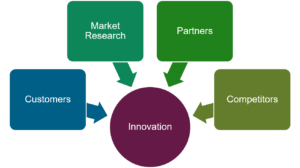The other day, a friend of mine sent me a joke. The joke was titled as ‘Busy Couple’ and presented a funny short conversation between a couple. In reality, it was about Active Listening. Here is how it goes.

The joke made me laugh and also think. It seems that the couple has a serious communication gap where they are just not listening to each other. It seems to be an over exaggeration, but, it is not. Some of this can be seen in the real life including the corporate world. In this article, we will focus on how Active Listening is a must for innovation.
The Network
In one of my earlier article, Innovation: In Search of Great Ideas (Part1), I have briefly touched upon the role of a network in spurring innovation. An innovative idea is like a network of neurons in our brain firing in a sequence that has never happened before. Its a network of neurons (sending and receiving information in the form of chemicals) that is responsible for an innovative idea. Similarly, a group, society or a company needs a network where information flows freely. Various studies have also suggested that innovation needs a diverse and dynamic network, to happen. This article, ‘How to Get Rich‘, by Jared Diamond, Professor of Geography at UCLA, explains with examples as to how the societies that were isolated saw no innovation.
Listening is the most important aspect of communication (sending and receiving information) and like the ‘Busy couple’ above, if the participants involved in communication are not listening to each other, there is no hope.
The Importance of Active Listening
Listening is the process of receiving, interpreting, and reacting to a message received from the speaker. There is a big difference between hearing and listening. Hearing is an involuntary process. If there is no physical obstruction stopping the sound waves reaching your eardrum, you will hear it. Listening on the other hand is a voluntary exercise and needs efforts on part of the listener.
Based on how the listener is reacting, the process of active listening can be divided into four categories. These are:
- Appreciative Listening
- Empathetic Listening
- Critical Listening
- Comprehensive Listening
Appreciative listening is when one is deriving pleasure or fun from whatever one is listening to. Empathetic listening takes place when a distressed friend is talking about his/her troubles. Critical Listening happens while analyzing the speaker’s words to accept or reject them. People generally employ Critical Listening during debates.
Comprehensive Listening involves all three types discussed above. Innovators need to employ the Comprehensive Listening. It is when one has to listen to what the customer is saying and comprehend it so as to match it with an existing solution or the need to devise a new solution. Innovators need to empathize with the customers to understand their problems. Sometimes if the expectations of the customer are not realistic, critical listening helps in understanding it and setting the expectations right. Appreciative Listening helps give thorough attention to the requirements of the customer.

Impact on Innovation
Innovators will need to actively listen to different groups of people based on what Innovation strategy the company follows. If the company follows Outside-In approach, one will need to listen to every relevant group outside the company, from customers to competitors.

However, if the company is following the Inside-Out approach of innovation, one will be listening more to the internal research groups, employees and of course the visionaries leading the initiative.
While the Outside-In approach results in innovations that have a market waiting to consume them, the Inside-Out approach many a times leads to disruptive ideas and creation of Blue Oceans. Apple follows the Inside-Out approach for innovation and we can say that they have created many new markets with their innovative offerings.
When different product groups or business segments in a company have to work in tandem on innovation, active Listening becomes even more important to understand each other better and act accordingly.
Conclusion
Being an active listener helps one associate and relate the new ideas and thoughts with the ones lying dormant in the brain. It helps expand the sphere of thinking and come out with new ideas by combining the already existing information with the new info.
To be an active listener, one needs to follow some guidelines.
- Evaluate the thoughts and ideas and not the person
- When the idea is not clear or well understood, paraphrase the understanding and seek more information
- Try to take the discussion a little beyond the ideas being discussed. A discussion on the implications of what is being suggested would help unravel more useful information and mature the overall idea, better.
- Non verbal responses in a discussion may encourage the speaker or shut them down. An active listener always ensures that the non verbal responses going to the speaker are encouraging and soliciting more information.
With growing distractions, the attention span of people has been reducing consistently. It is very necessary for the companies to cultivate the habit of active listening in their employees. Active listening will improve the quality of innovative ideas while improving the productivity.
Active listening can help influence both, the top line as well as bottom line performance.
- Four Growth Strategies to Scaleup Your Business - March 14, 2021
- Innovative India: Platforms For Billion+ People - January 5, 2021
- Innovative India: Searching For Lost Glory - October 15, 2020


